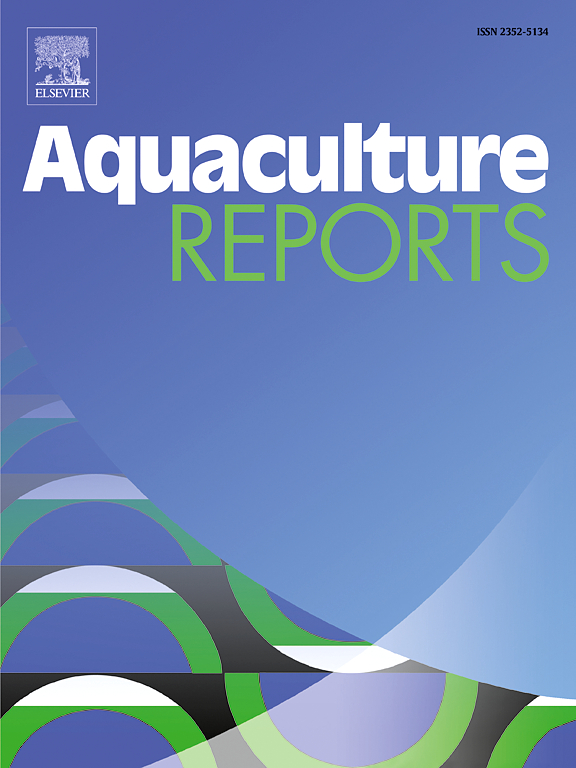Enzymatic hydrolysis of cottonseed protein enhances appetite and intestinal health of Litopenaeus vannamei
IF 3.2
2区 农林科学
Q1 FISHERIES
引用次数: 0
Abstract
This study examined the effects of enzymatic hydrolysis cottonseed protein (ECP) on the appetite and intestinal health of Litopenaeus vannamei (0.16 ± 0.01 g). Based on the control diet (fishmeal 18 %, crude protein 40 %, crude fat 7.5 %), 2 %, 4 %, 6 %, 8 % and 10 % of ECP were added to replace fishmeal in equal amounts to formulate six isonitrogenous and iso-lipidic experimental diets named ECP0 (Control), ECP2, ECP4, ECP6, ECP8, and ECP10, respectively. After an 8-week feeding trial, the serum orexin levels were significantly increased (P < 0.05); and leptin, peptide YY and cholecystokinin were significantly reduced when shrimp ingested diet contained ECP, as well as their genes expression levels (P < 0.05). Compared with the ECP0 group, the weight gain rate of the shrimps in group ECP2 had significantly increased (P < 0.05). Besides, intestinal fold height and muscular thickness of shrimps in group ECP2 were markedly increased, and up-regulated genes expression levels for periplasmic membrane factors (P < 0.05). Significantly increased intestinal amylase, lipase, trypsin and chymotrypsin activities were found in shrimps fed diet ECP2 and ECP4 (P < 0.05). The addition of ECP significantly decreased Vibrio, Photobacterium and Tenacibaculum abundance, and increased Ruegeria and Marivita abundance in shrimp intestine (P < 0.05), especially the supplemented 2 % ECP significantly improved the membrane transport and amino acid metabolism functions of the intestinal flora in shrimps (P < 0.05). Therefore, the addition of 2–4 % ECP by replacing fishmeal at an equal level could enhance growth by improving appetite, intestinal morphology and the composition of gut microbiota for L.vannamei.
酶法水解棉籽蛋白促进凡纳滨对虾食欲和肠道健康
本研究考察了酶解棉籽蛋白(ECP)对凡纳滨对虾食欲和肠道健康的影响(0.16 ± 0.01 g)。在对照饲料(鱼粉18 %、粗蛋白质40 %、粗脂肪7.5 %)的基础上,等量添加2 %、4 %、6 %、8 %和10 %的ECP替代鱼粉,分别配制成6种等氮等脂试验饲料,分别为ECP0 (control)、ECP2、ECP4、ECP6、ECP8和ECP10。饲喂8周后,血清促食欲素水平显著升高(P <; 0.05);饲粮中添加ECP显著降低了虾的瘦素、YY肽和胆囊收缩素及其基因表达量(P <; 0.05)。与ECP0组相比,ECP2组对虾增重率显著提高(P <; 0.05)。此外,ECP2组对虾肠折叠高度和肌肉厚度显著升高,质周膜因子基因表达量上调(P <; 0.05)。饲粮ECP2和ECP4显著提高了肠道淀粉酶、脂肪酶、胰蛋白酶和凝乳胰蛋白酶活性(P <; 0.05)。添加ECP显著降低了对虾肠道弧菌、光杆菌和tenacacbaculum的丰度,提高了Ruegeria和Marivita的丰度(P <; 0.05),特别是添加2 % ECP显著提高了对虾肠道菌群的膜转运和氨基酸代谢功能(P <; 0.05)。由此可见,以等量替代鱼粉添加2 ~ 4 % ECP可通过改善凡纳米对虾的食欲、肠道形态和肠道菌群组成来促进其生长。
本文章由计算机程序翻译,如有差异,请以英文原文为准。
求助全文
约1分钟内获得全文
求助全文
来源期刊

Aquaculture Reports
Agricultural and Biological Sciences-Animal Science and Zoology
CiteScore
5.90
自引率
8.10%
发文量
469
审稿时长
77 days
期刊介绍:
Aquaculture Reports will publish original research papers and reviews documenting outstanding science with a regional context and focus, answering the need for high quality information on novel species, systems and regions in emerging areas of aquaculture research and development, such as integrated multi-trophic aquaculture, urban aquaculture, ornamental, unfed aquaculture, offshore aquaculture and others. Papers having industry research as priority and encompassing product development research or current industry practice are encouraged.
 求助内容:
求助内容: 应助结果提醒方式:
应助结果提醒方式:


